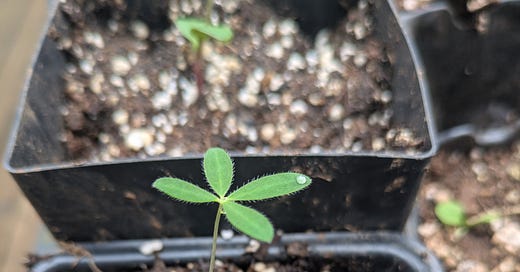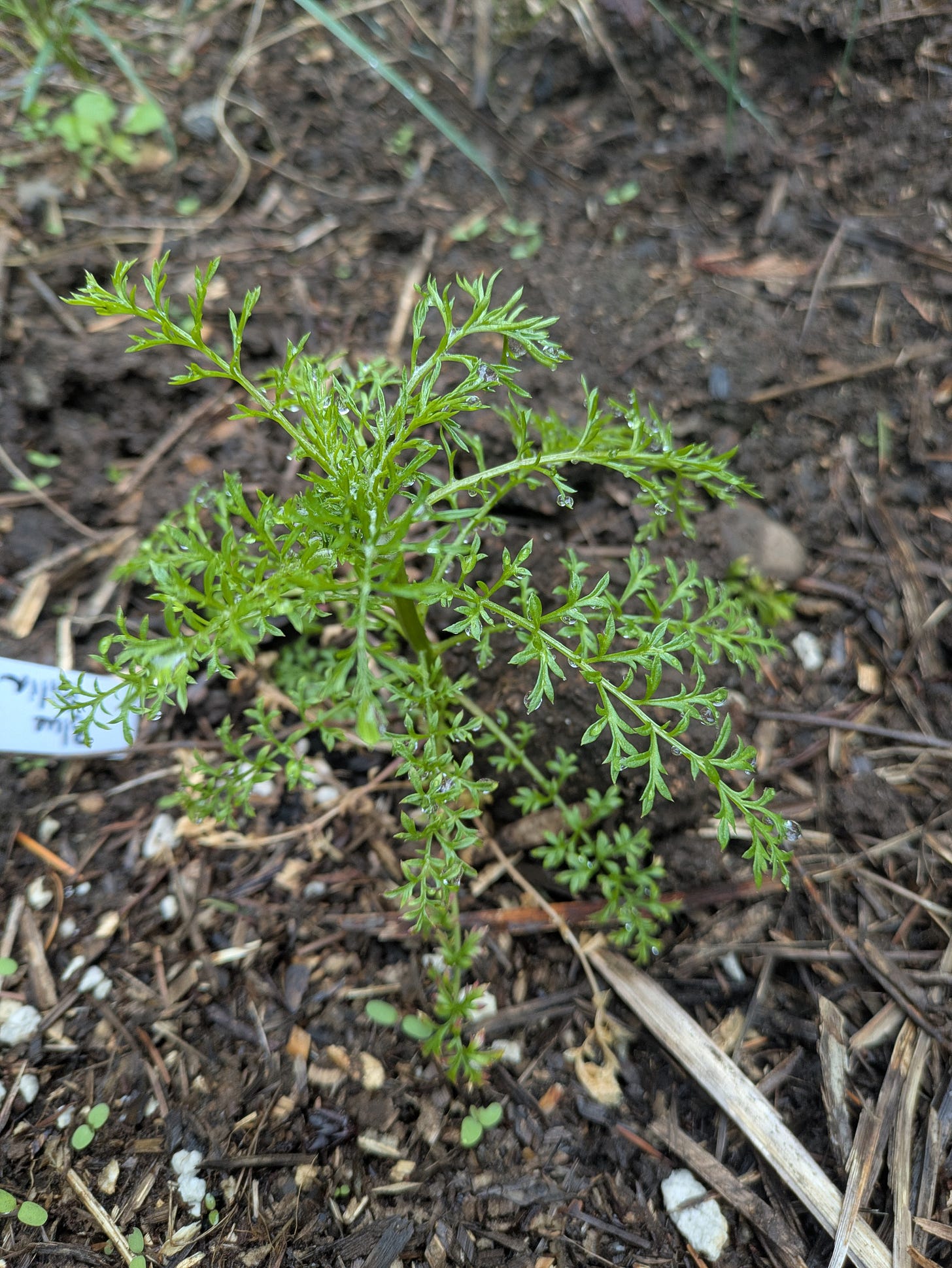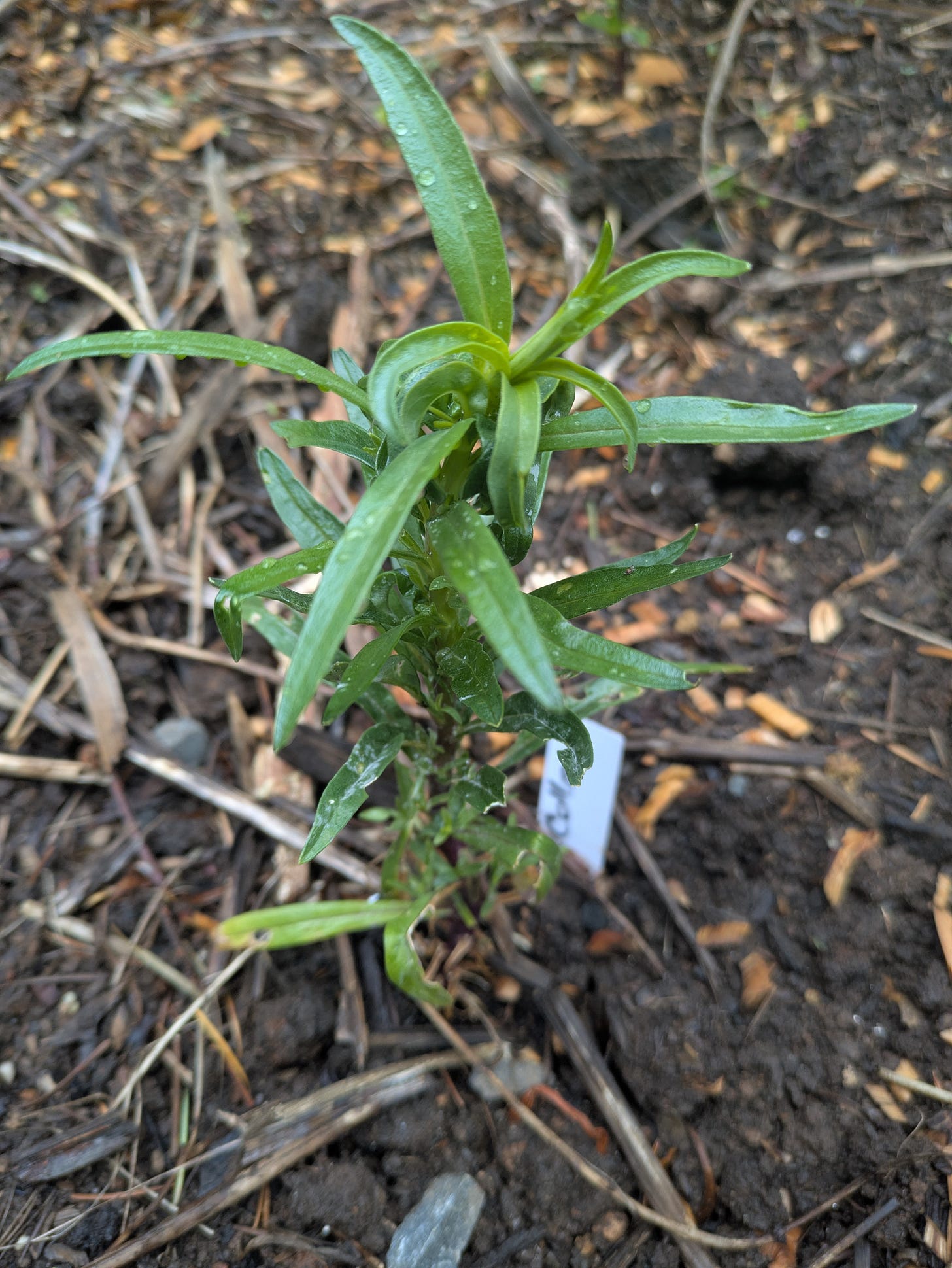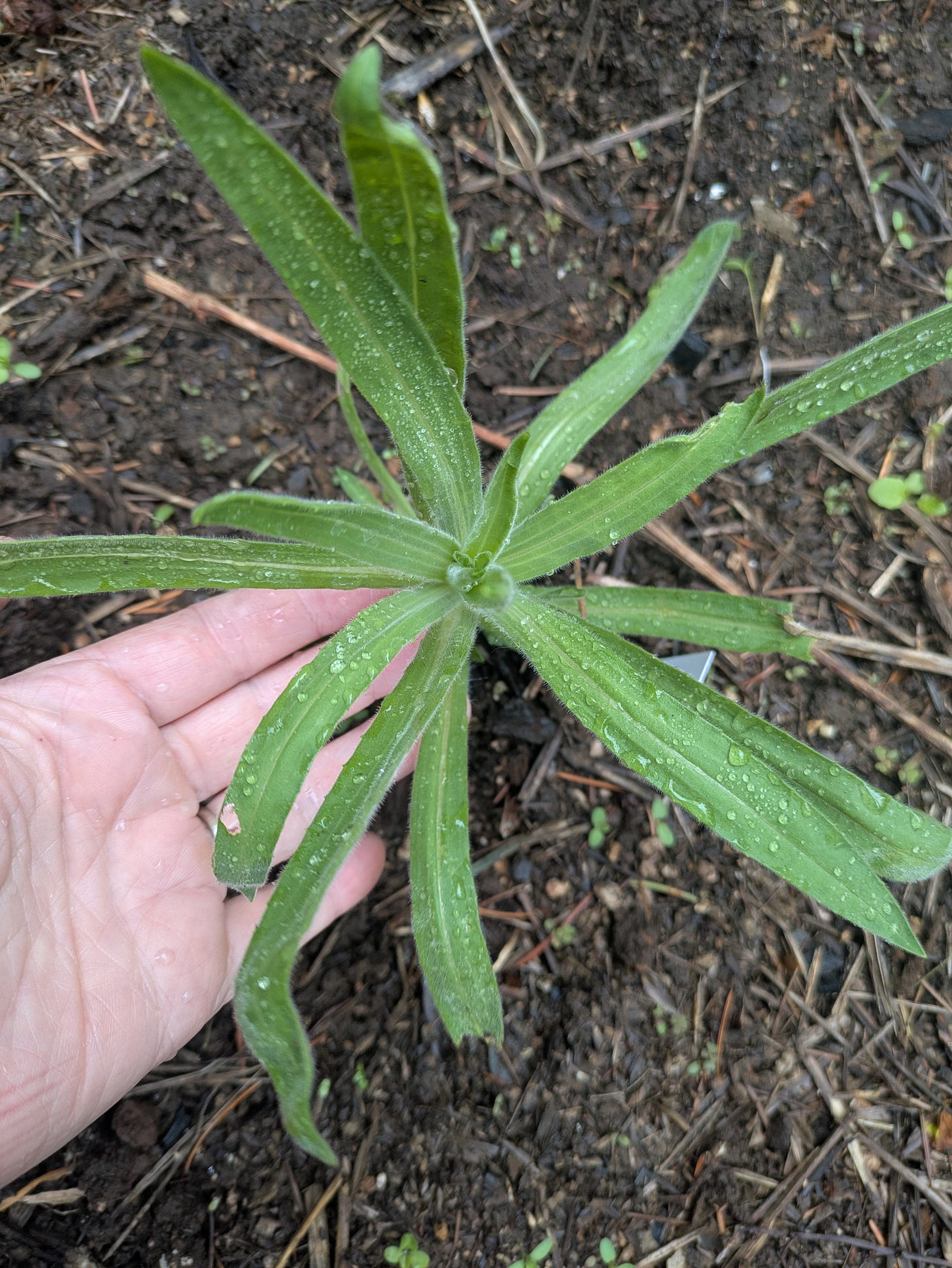Germinating native plant seeds
A collection of personal notes on germinating native plant seeds
Intro
As I pull back invasive weeds on my small Clackamas County acreage, I find I’ve got a lot of space to fill. No way will this be an affordable task if I were to buy plant starts for everything and fill them in. I decided that since I’ve gotten relatively confident at getting annual seeds such as vegetable seeds to grow well, it’s time to give germinating native seeds a genuine try.
However, germinating native seeds is a completely different ball game than tomatoes or squash. They have vastly different requirements - stratification, scarification, soil temp, seed depth, timing of year, etc.
This is going to be a post that will regularly be updated - as I find more germination notes and have more experiential notes to add.
Soil & transplant info
On my property, I’ve got a ridiculous amount of slugs that tend to devour new seedlings of all kinds. I also have fairly clayey soil and/or soil that is covered in wood chip mulch. These are not easy conditions for most seeds to germinate in, so most of what I’m doing is raising transplants.
The soil that I’m using is an experiment with different mediums. I’ve used cold-pressed compost and clayey virgin topsoil mixed with vermiculite for some. The trouble with this method is that a zillion weed seedlings come up, and if I don’t know what the target seedling looks like, it is troublesome to figure out unless really obvious such as grass or lupine.
The other medium I’m trying is straight up Black Gold Seedling mix. I am not fond of the idea of using peat-based mixes in plastic bags, but I have not found a good alternative. Coconut coir is just as environmentally troublesome as peat. In the past I’ve also bought raw materials and mixed my own seed-starting mix, but haven’t gotten around to doing that recently.
Note: all of my seeds are stored in the freezer, which may enhance germination for some of these species.
Agastache Urticifolia
Grower notes:
Klamath Siskiyou: “30-60 days cold-moist stratification. Sow outside in fall to late winter.”
Personal experience: started a six pack of seed late May 2025 indoors in Black Gold seedling mix. The tiny seeds came up quickly.
American Vetch - Vicia Americana
Grower notes:
Klamath Siskiyou: “No pretreatment required. Pre-soak the seeds in warm (not boiling) water for 24 hours then sow outside in fall to early spring.”
Personal experience: started a six pack of seed late May 2025 indoors in Black Gold seedling mix. I have not seen them come up, but it is early yet.
Big Deervetch - Lotus crassifolius/Hossackia Crassifolia
Grower notes:
Klamath Siskiyou: “Soak in hot (not boiling) water for 24 hours, then 60-90 days cold-moist stratification. Sow in fall to late winter.”
USDA: “Big deervetch seed has combined dormancy, meaning it has both physical and physiological inhibitions to germination, so seed should be scarified and stratified prior to sowing.”
Personal experience: purchased 2025, will update after I plant next season.
Blue Gilia - Gilia Capitata
Grower notes:
Sparrowhawk: “Simply spread the seeds on the surface of the soil and do not cover. They will require little to no cold stratification. They should germinate and grow into tiny sprouts in the fall, then sit tight without any more growth until spring when they take off. If sowing in spring, the earlier the better as cooler temps may enhance germination.”
Xera: “It often grows and self sows in the disturbed slopes of road cuts, dry hillsides. In the garden it LOVES good conditions and will be much larger, bloom longer, with flowers of a darker hue of blue.”
Personal experience: I bought a seedling in 2025 and planted it in a seemingly suitable space without heavy mulch to see if it would reseed next year.
Buttercup, “Straight Beak” Ranunculus Orthohynchus
Seed producer germination notes:
Willamette Wildings: “Stratification: little to none, possibly 2 weeks. Depth: shallow, cover lightly. Can be fall or spring sown. It may just need a short period of cool temperatures to germinate - cool temperatures may enhance germination. If fall down, it may flower the following spring. If spring planting, early spring while temps are still cool and wet is best.”
Xera: “Birds foot buttercup thrives in areas that are often submerged in winter Though it favors wet sites in will easily accommodate dry conditions as well and is happy in upland situations. Short lived perennial (3-5 years). Very forgiving native that will happily reseed if given room.”
Sparrowhawk: “Sowing in fall or early spring is ideal, to take advantage of winter rains. Short stratification if any (possibly up to two weeks), so late spring is possible, if supplemental water is provided.”
Personal experience:
3/20/2025 I sowed - outdoors - a six inch pot with a rough mix of half topsoil and half vermiculite. As of 5/3 I see quite a few seedlings. Transplanted out about two weeks later. The seedlings have survived but haven’t grown much as of 6/2.
3/20/2025 I broadcast seeded the rest of the seeds in a wetland area. I have noticed a few of them come up, but they are still very small as of 6/2.
Celery-leafed lovage or licorice root - Ligusticum Apiifolium
Seed producer notes:
Willamette Wildings: “Stratification: 12 weeks… germination sporadic”
Xera: “Self sows moderately.”
Personal experience: seed purchased for fall 2025 planting.
Checkermallow - Meadow - Sidalcea Campestris
Seed Producer Notes:
Willamette Wildings: “stratification 3-12 weeks. Can be fall or early spring sown. Seeds are considered non-dormant but cool temps enhance germination. Germination occurs sporadically over a long period of time. Fall/winter sown seed may not germinate until temps are warm in spring.”
Klamath Siskiyou has a different species of checkermallow listed on its website, which may offer a clue to the germination needs. “60-90 days cold-moist stratification. Sow outside in fall.”
Personal experience: seed purchased 2025. Given the long period of stratification needs I thought it best to try in the fall.
Clarkia, Diamond Clarkia Rhomboidea & Clarkia Purpurea (or Winecup Clarkia)
Seed producer notes:
Willamette Wildings: seed pack notes. “very short stratification if any. Do not cover seed. Can be fall or spring sown - but spring sowings are best done early as cool temps may enhance germination. Sowing in situ versus pots tends to produce sturdier, more robust plants.
Sparrowhawk: Can be fall or spring sown since it requires only short stratification, if any. If spring sowing, cool temperatures may enhance germination so plant seed as early as possible. Spring sown plants may be smaller in stature than fall sown when they bloom. Broadcast seeds at a rate of approximately 60 seeds per square foot. If planting in a small pot or directly "in situ", use just a tiny pinch per location. Do not cover with soil. Each packet contains approximately 325 seeds.
Personal experience:
3/20/2025 planted a six pack of Diamond Clarkia, outdoors, with half vermiculite and half top soil. They came up within a few weeks and are easy to identify. Late April, I decided to transplant them out. A week-ish later I checked on them and they were still quite small but slugs had not yet gotten to them, so they may survive. When I planted I watered them in, and put a very narrow band of mulch around them to help support the water, but left the ground largely open so that they could reseed the following year.
5/2/2025 I decided to try another six pack of Diamond Clarkia to see if planting out this late in the year would be successful. This time I used the Black Gold Potting mix to see if it would work. It did. They came up fairly quickly and I transplanted them out just after a rainy spell. I have not seen any slugs on this species.
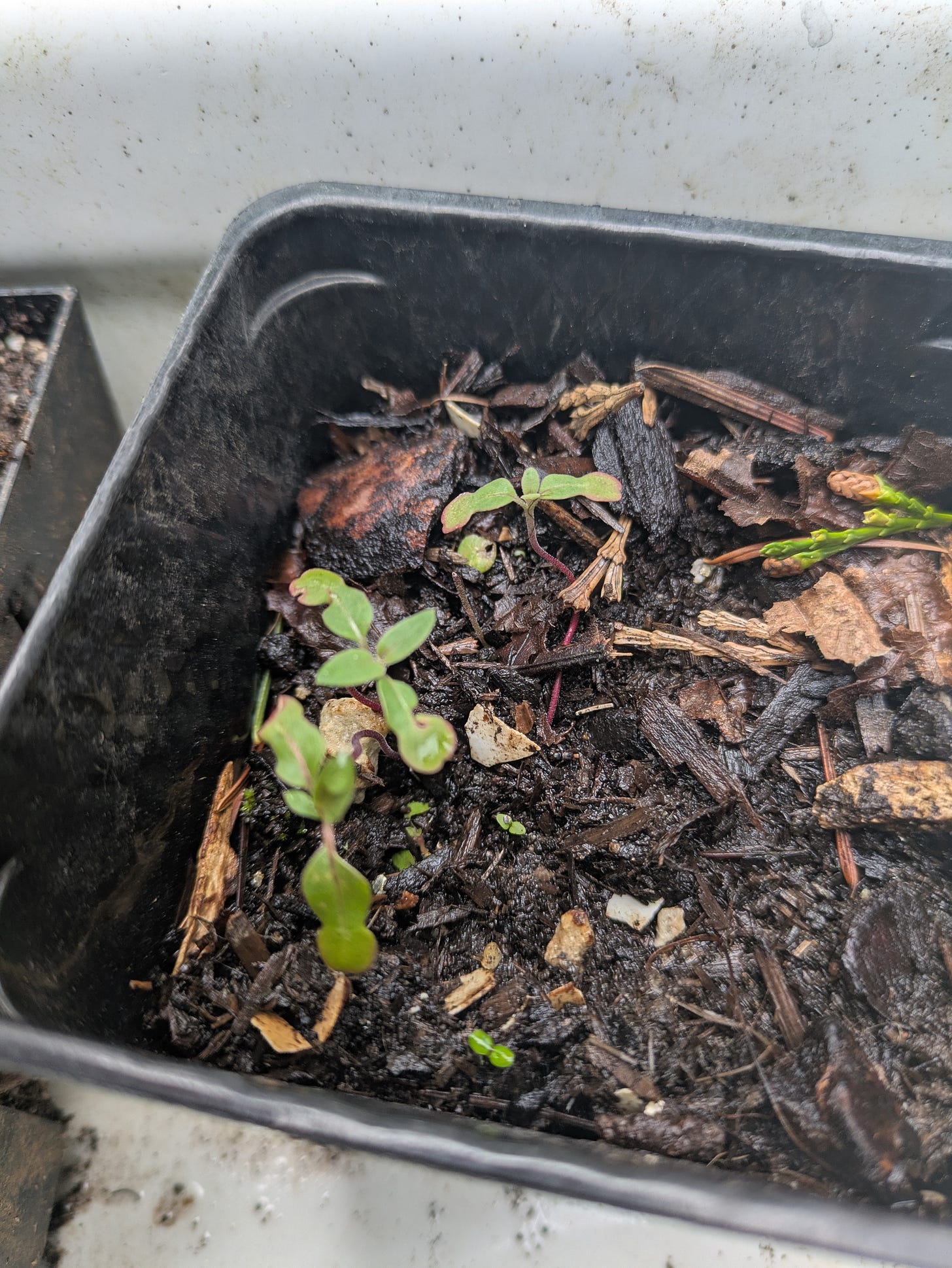
Clover - trifolium
Last year I bought a six pack of one of the native clovers from Symbiop. They were devoured immediately by slugs. I won’t be trying again, as slug control on my acreage is just not practical.
Collinsia Grandiflora - large flowered blue eyed Mary
Grower notes:
Xera: “This is a very reliable re-seeder if you give it some open ground and check for slugs.” (uh-oh)
Willamette Wildings: “Germination make take longer and require a longer period of cool temps than most annuals.”
Northwest Meadowscapes: “With minimal competition, this is an annual that can re-seed itself, creating colorful swaths, especially around seasonally flooded locations, year after year.”
Personal experience: Seed purchased spring of 2025, will start in the fall.
Collomia Grandiflora
Xera: “Reseeds prolifically. To 2′ tall. Cute cut flower. Nice native to let wander your garden.”
Willamette Wildings: “Stratification: short - 2 weeks. Cooler temps are required for germination.”
Klamath Siskiyou: “No pretreatment required. Sow outside in fall to early spring.”
Personal experience:
I bought a small start in 2025, and placed it in an area of the garden where the soil is without mulch but has good moisture and drainage. It is supposed to reliably reseed. We will find out.
Columbine, red - Aquilegia Formosa
Seed producer notes:
Willamette Wildings: seed pack notes: “stratification 6-8 weeks. Surface to shallow depth. Does best with natural stratification (vs in fridge). Initial germination after strat will be spotty and initial growth is slow. Seedlings need light and constant moisture - water to keep soil moist but not soggy.”
Klamath Siskiyou: “60-90 days cold-moist stratification. Sow outside in fall to late winter.”
Northwest Meadowscapes: “Do note, it can take some patience and dedication to grow columbine from seed. We recommend sowing in deep, well-watered containers (such as our DEEPOT kits) in a shaded location, and protected from slugs, until the seedlings are large enough to transplant.”
Personal experience: purchased 2025 to try fall planting.
Cow Parsnip - Heracleum Maximum
Grower germination notes:
Northwest Meadowscapes: “Under natural conditions, cow parsnip is dependent on having enough bare ground to re-seed itself, but unlike it’s invasive relatives, it is not an aggressively spreading plant. In fact if you want it to stick around, you may need to intentionally plant more after several years.”
Willamette Wildings: “Stratification: 12-16 weeks. If stratifying in the fridge they may sprout earlier than 12 weeks… suggested the seeds be soaked 24-28 hours hours before sowing.”
Klamath Siskiyou: “Cowparsnip is short-lived, but will reseed itself. 120 days cold-moist stratification. Sow outside in fall.”
Personal experience:
Summer/2024 purchased a start from Xera. I was under the impression from various garden literature I have read that this is a wetland plant, but it croaked immediately when I planted in my wetland. It looked like rot.
5/2025 purchased seed to try again in better drained location. Will try in the fall.
Dogbane Hemp - Apocynum Cannibium
Grower notes:
I’m finding a lot of confusing information about germinating this species. I will update when I get the seed package.
Downingia Eleagans - Last year I bought a very stocky seedling from Xera. Supposed to reseed reliably. Put it in the ground that it favors and it almost immediately succumbed to slugs. Will not be trying again.
Gaillardia Aristata
Grower notes:
USDA: “The seed does not require cold stratification treatment to break dormancy.”
Personal experience: started seed late May 2025. Black Gold potting mix indoors. The seeds came up within a few days.
Gumweed - Grindelia Integrifolia
Seed producer notes:
Willamette Wildings: “Stratification is short, if any. Can be fall or spring sown. Cool temps may enhance germination, so if spring planting, early is better than mid to late spring. Spring sown seed should germinate within 3-4 weeks. Fall sown seeds may not germinate until temps warm in the spring.”
Klamath-Siskiyou seeds has a different species of Grindelia listed on its website, which may be helpful in germinating Grindelia Integrifolia seeds. “30-60 days cold-moist stratification. Sow outside in fall to late winter.”
Personal experience:
3/20/2025 sowed several in a six inch pot, with half vermiculite and half top soil. As of 5/3/2025 I think I notice one seedling, but I’m not sure. I brought the pots indoors to see if the warm temps would enhance germination rate. It did not. The single seedling was transplanted to a six inch pot and is struggling badly.
Fescue, Roemer’s - Festuca Roemeri
Seed producer notes:
Willamette Wildings: “No stratification. Can be fall or spring sown - if spring sowing, earlier is better than mid to late spring as cool temps may enhance germination. Some literature suggests a cool period of about 14 days is beneficial. Light may enhance germination.
Personal experience:
3/20/2025 sowed several in a 4” pot with roughly half vermiculite and half top soil. Within a few weeks they were up and growing. Early may transplanted several into their own 4” pots. Seems easy.
Lomatium Utriculatum
Grower notes:
Klamath Siskiyou: “60-90 days cold-moist stratification. Sow outside in fall to late winter.”
Personal experience: seed purchased 2025, will start in the fall.
Lupine, Big & Broadleaf - Lupinus Polyphyllus & Lupinus Latifolius
Seed Producer notes
Willamette Wildings: “Stratification: short - if any (with scarification).” Unfortunately I lost the seed package, but I do recall that it recommended soaking in hot, not boiling water, and that seed germination is erratic.
Personal experience:
I have previously had this plant in my yard. Sadly, it is a short-lived perennial. Supposed to reseed, but nothing came up. I have also attempted to direct seed in the past. I saw some seedlings come up, but they disappeared. I suspect slugs, and I suspect this will be a plant that if I want I will have to grow from seed periodically.
3/20/2025 placed a cup of water in the microwave for two minutes, then popped a few lupine seeds in. Forgot about them for two days. Then potted up outside in half vermiculite and half top-soil. As of 5/3 about half have germinated. They have been potted up into 4” pots and in an area that is hopefully protected from slugs. They are developing well. Transplanted the 4” pots on 5/30.
5/1/2025 placed a cup of water in the microwave for 2 minutes, then popped a whole bunch of lupine seedlings in. Waited for a few hours, then potted them into six inch pots. Kept them indoors for a day while the day was unseasonably hot, then moved outdoors to let them experience natural temp fluctuations. As of 5/13, a few have already popped up. Many were then devoured by chipmunks.
5/12/2025 pre-soaked in hot water as above an entire packet of broadleaf lupine and planted the next day. As of 6/2, six have come up.
Madia Elegans - tarweed
Grower notes:
Northwest Meadowscapes: “This late season bloomer also has the fantastically amazing ability to set deep tap roots that allow it to prosper in the latest, hottest days of summer, even in heavy clay soils, months after the last rainfall.”
Sparrowhawk: “Recommend sowing between September and November or in March so that seeds will benefit from seasonal rains. If sowing in April or May, seeds will benefit from supplemental water to encourage strong growth the first year.”
Willamette Wildings: “Stratification: short - if any. Cool temps may enhance germination.”
Xera: “Re-seeds in places that it likes, mostly sunny, open places with good drainage.”
Personal notes:
-years ago I planted a start in a garden that might have been a little too shady, compacted, or perhaps I mulched over the following year’s seedlings, because I did not see it return.
-April 2025. Purchased a start, planted it in open ground, will see if it reseeds on its own.
Milkweed, showy - Asclepias Speciosa
In the book “The Milkweed Lands” there is a note that this particular species varies in its germination requirements. Showy Milkweed from one area requires log stratification periods, seed collected from other areas may need very short stratification or no stratification at all.
Nodding Bur Marigold - Bidens Cernua
Grower Notes:
Northwest Meadowscapes: “Despite its annual lifecycle, nodding bur-marigold re-seeds itself fairly well in optimal locations…”
Everwilde: “Sowing: Direct sow in late fall, planting he seed just below the surface of the soil. For spring planting, mix Nodding Bur Yellow Marigold seeds with moist sand and store it in the refrigerator for 60 days before planting. After the last frost, direct sow the seed just below the surface of the soil and lightly press down the soil; keep it moist until germination. Thin or transplant seedlings.”
Minnesota Board of Water & Soil: “The seeds need a period of cold-moist stratification so it is best to spread them in the fall on saturated, bare soils to allow them to naturally stratify over winter.”
Personal experience:
Purchased seed 2025, will sow direct in the fall.
Pacific Snakeroot - Sanicula Crassicaulis
Grower Notes
Klamath Siskiyou: “30-60 days cold-moist stratification. Sow outside in fall or early spring.”
Personal experience: seeds purchased 2025, will update after I have sown them in the fall.
Popcorn Flower, Fragrant - Plagiobothris Figuratis
Grower Notes:
Xera: “Excellent performance in rain gardens and a very reliable re-seeding plant. Full sun and water potted plants to establish. Self sown seedlings get by with no supplemental irrigation.”
Northwest Meadowscapes: “Fragrant popcorn flower has a fascinating ecology as a vernal pool plant. In wild settings, the seeds survive under water in seasonally flooded fields and ponds, germinating as the water recedes, and forming widespread mats of white blooming color in early summer.”
Willamette Wildings: “Stratification: none.”
Personal experience:
4/2025 purchased a start from Xera, planted it in wet soil that dries a touch in summer. So far it seems to be surviving and thriving without any slug abuse. I also have some seed on hand to spread around to other wet areas in the fall. As of 6/2 I have noticed the plant growing, but also a lot of slug munching. This makes me question whether small seedlings would withstand slug damage.
Prairie Junegrass - Koeleria Macrantha
Willamette Wildings: Seed pack notes: “no stratification. Do not cover. Can be fall or spring sown - but spring sowing is recommended - small fall germinates can be damaged by extreme winter weather. Cool temps enhance germination so early spring is best. Light enhances germination - do not cover.”
Personal notes:
3/20/2025 sowed several in a 4” pot outdoors, in half vermiculite and half topsoil. Within a few weeks they were up, and I’ve transplanted the tiny seedlings into their own 4” pot. Seems easy.
Seablush - Plectritis Congesta
Grower notes:
Willamette Wildings: “Stratification: short - if any. Cool temps may enhance germination.”
Xera: “Fun to grow heavily reseeding annual that also makes a sweet cut flower. Seedlings have paddle shaped true leaves with a rubbery texture.”
Personal experience: I sowed seed years ago near my wetland. It bloomed fabulously the first year, nothing the second, although it is supposed to reseed itself. I think I may have had too many invasive plants during the time. I am going to try again.
Spike Primrose - Epilobium Densiflorum
Grower notes:
Xera: “Water in potted plants well and you will likely see seedlings in open disturbed sites in the spring. The seedlings of this Epilobium mimic several more weedy types (they are native but kind of rambunctious).”
Northwest Meadowscapes: “As a fast growing annual species adapted to fire and disturbance, we like this rapid colonizer for integrating into sparse grassy meadows, areas recently cleared for construction, wet ditches, rain gardens, and bioswales.”
Personal experience:
Purchased a start 2025, planted where it seems to thrive and without mulch so that next year’s seeds come up. It is supposed to reseed itself, we will find out.
Violet, Canary - Viola Praemorsa
Grower notes:
Willamette Wildings: “Stratification: long - 12 weeks… young plants go dormant early their first season but put on a lot of growth in their second.”
Personal experience: seed purchased 2025, will try sowing in the fall.
Yarrow - Achillea Millefolium is supposed to be wickedly easy to grow, and self sow all over the place when happy. I have tried a few times to add cultivars and the straight species (as plant starts) to my property, but it always fails to do well. I suspect that it was in too much shade and the soil too dense. I’ve since opened up space that is sunnier and better drained, so trying again.
Seed producer germination notes:
Klamath-Siskiyou: “No pretreatment required. Sow in fall or spring on or just below the soil surface. Needs warm soil and light to germinate.”
Willamette Wildings: notes on seed packet. “Can be fall or spring sown. Fall-winter sown seeds may not germinate until temps warm in the spring. Spring sown seeds should germinate within a couple of weeks. If planting in small pots outside, protect from heavy rains so seed does not get washed away.”
Personal experience:
3/20/2025 sown several seeds in light topsoil mixed with vermiculite. As of late April they did not come up. Moved the seeds indoors and several days later still do not see germination.
5/2/2025 sown a six-pack indoors with Black Gold Seedling mix and raising indoors, where temps are warm, under seed lights. Several seeds shot right up within a few days, while the previous sowing attempt still has not sprouted. This tells the soil was too cold, but still did not sprout when warmed up because the seeds rotted. I then put the seedlings outdoors, when it rained heavily. The seedlings died. Either they need more heat for longer periods or more drainage added.
Donations: the information that is provided here is free for gardeners of all financial means. If you’d like to financially support this site, you can make a one-time donation or monthly subscriptions on this link. All proceeds will fund more garden projects to share here with you, dear readers, thank you! And thank you SO much to the folks that have supported me. Your contributions mean so much.

